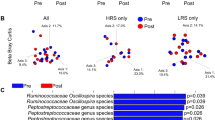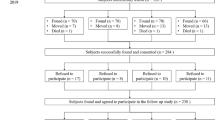Abstract
Background/Objectives:
Vitamin D and probiotics are nutrients of interest in the context of type 1 diabetes (T1D). We assessed the prevalence of and factors associated with vitamin D and probiotic supplementations among young children with genetic risk of T1D.
Subjects/Methods:
Use of supplements during the first 2 years of life was collected prospectively from 8674 children in The Environmental Determinants of Diabetes in the Young (TEDDY) study.
Results:
Single and/or multivitamin/mineral (MVM) supplements were reported by 81% of the children. The majority of participants in Finland, Germany and Sweden (97–99%) and 50% in the United States received vitamin D supplements that were mostly MVMs. Probiotics use varied from 6% in the United States to 60% in Finland and was primarily from probiotics-only preparations. More than 80% of the vitamin D and probiotics supplementation was initiated during infancy, and more than half of the uses lasted longer than a year. Being the first child, longer duration of breastfeeding, born in a later year, older maternal age and higher maternal education level were associated with both vitamin D and probiotics use. Shorter gestational age and mother not smoking during pregnancy were associated with a higher likelihood of probiotics supplementation only.
Conclusions:
Vitamin D and probiotics supplementations are popular in children 0–2 years old and are associated with common factors. Data documented here will allow evaluation of the relationship between early childhood dietary intake and the development of islet autoimmunity and progression to T1D.
This is a preview of subscription content, access via your institution
Access options
Subscribe to this journal
Receive 12 print issues and online access
$259.00 per year
only $21.58 per issue
Buy this article
- Purchase on Springer Link
- Instant access to full article PDF
Prices may be subject to local taxes which are calculated during checkout

Similar content being viewed by others
References
Virtanen SM . Dietary factors in the development of type 1 diabetes. Pediatr Diabetes 2016; 17: 49–55.
Hyppönen E, Läärä E, Reunanen A, Järvelin M-R, Virtanen SM . Intake of vitamin D and risk of type 1 diabetes: a birth-cohort study. Lancet 2001; 358: 1500–1503.
Zipitis CS, Akobeng AK . Vitamin D supplementation in early childhood and risk of type 1 diabetes: a systematic review and meta-analysis. Arch Dis Child 2008; 93: 512–517.
Simpson M, Brady H, Yin X, Seifert J, Barriga K, Hoffman M et al. No association of vitamin D intake or 25-hydroxyvitamin D levels in childhood with risk of islet autoimmunity and type 1 diabetes: the Diabetes Autoimmunity Study in the Young (DAISY). Diabetologia 2011; 54: 2779–2788.
Uusitalo U, Liu X, Yang J, Aronsson CA, Hummel S, Butterworth M et al. Association of early exposure of probiotics and islet autoimmunity in the teddy study. JAMA Pediatr 2016; 170: 20–28.
Rewers M, Ludvigsson J . Environmental risk factors for type 1 diabetes. Lancet 2016; 387: 2340–2348.
Sorini C, Falcone M . Shaping the (auto)immune response in the gut: the role of intestinal immune regulation in the prevention of type 1 diabetes. Am J Clin Exp Immunol 2013; 2: 156–171.
Wagner CL, Greer FR,, the Section on Breastfeeding Committee on Nutrition.. Prevention of rickets and vitamin D deficiency in infants, children, and adolescents. Pediatrics 2008; 122: 1142–1152.
Koletzko B, Bauer C, Brönstrup A, Cremer M, Flothkötter M, Hellmers C et al. Key statements for infant nutrition during the first year of life. Monatsschr Kinderheilkd 2013; 161: 237–246.
German Nutrition Society. The DACH Reference Values, 2017. Available at: https://www.dge.de/wissenschaft/referenzwerte/ (last accessed 23 March 2017).
Nordic Council of Ministers. Nordic nutrition recommendations. Nordic Council of Ministers: Copenhagen, Denmark, 2012. Report no.: 978-92-983-2629-2.
Hasunen K, Kalavainen M, Keinonen H (eds). The Child, Family, and Foodnutrition Recommendations for Infants and Young Children as well as Pregnant and Breastfeeding Mothers. Publications of the Ministry of Social Affairs and Health: Helsinki, Finland.
Virtanen S, Sarlio-Lahteenkorva S, D-vitamiinivalmisteiden käyttösuositukseen muutoksia, http://www.mynewsdesk.com/fi/pressreleases/d-vitamiinivalmisteiden-kaeyttoesuositukseen-muutoksia-562100 (last accessed 23 March 2017).
Thomas DW, Greer FR . Nutrition Co, Section on Gastroenterology H, Nutrition.. Probiotics and prebiotics in pediatrics. Pediatrics 2010; 126: 1217–1231.
The TEDDY Study Group. The Environmental Determinants of Diabetes in the Young (TEDDY) study: study design. Pediatr Diabetes 2007; 8: 286–298.
Hagopian WA, Lernmark A, Rewers MJ, Simell OG, She JX, Ziegler AG et al. TEDDY—The Environmental Determinants of Diabetes in the Young: an observational clinical trial. Ann N Y Acad Sci 2006; 1079: 320–326.
Moyers S, Richesson R, Krischer J . Trans-Atlantic data harmonization in the classification of medicines and dietary supplements: a challenge for epidemiologic study and clinical research. Int J Med Inform 2008; 77: 58–67.
World Health Organization Obesity: Preventing and Managing the Global Epidemic. Report of a WHO Consultation. WHO: Geneva, Switzerland, 2000.
Pflüger M, Winkler C, Hummel S, Ziegler AG . Early infant diet in children at high risk for type 1 diabetes. Horm Metab Res 2010; 42: 143–148.
Brekke HK, Ludvigsson J . Vitamin D supplementation and diabetes-related autoimmunity in the ABIS study. Pediatr Diabetes 2007; 8: 11–14.
Blomquist HK, Frangsmyr A, Hernell O, Stenberg B, Back O . Dietary intake of vitamin D during the second half of infancy in Swedish infants. Scand J Nutr 2004; 48: 173–177.
Rasanen M, Kronberg-Kippila C, Ahonen S, Uusitalo L, Kautiainen S, Erkkola M et al. Intake of vitamin D by Finnish children aged 3 months to 3 years in relation to sociodemographic factors. Eur J Clin Nutr 2006; 60: 1317–1322.
Marjamäki L, Räsänen M, Uusitalo L, Ahonen S, Veijola R, Knip M et al. Use of vitamin D and other dietary supplements by Finnish children at the age of 2 and 3 years. Int J Vitam Nutr Res 2004; 74: 27–34.
Bailey RL, Gahche JJ, Thomas PR, Dwyer JT . Why US children use dietary supplements. Pediatr Res 2013; 74: 737–741.
Smith LB, Lynch KF, Baxter J, Lernmark B, Roth R, Simell T et al. Factors associated with maternal-reported actions to prevent type 1 diabetes in the first year of the TEDDY Study. Diabetes Care 2014; 37: 325–331.
Vanderhoof JA, Young R . Probiotics in the United States. Clin Infect Dis 2008; 46 (Suppl 2), S67–S72.
Savino F, Pelle E, Palumeri E, Oggero R, Miniero R . Lactobacillus reuteri (American Type Culture Collection Strain 55730) versus simethicone in the treatment of infantile colic: a prospective randomized study. Pediatrics 2007; 119: e124–e130.
Salminen MK, Tynkkynen S, Rautelin H, Saxelin M, Vaara M, Ruutu P et al. Lactobacillus bacteremia during a rapid increase in probiotic use of Lactobacillus rhamnosus GG in Finland. Clin Infect Dis 2002; 35: 1155–1160.
Hummel S, Vehik K, Uusitalo U, McLeod W, Aronsson CA, Frank N et al. Infant feeding patterns in families with a diabetes history—observations from The Environmental Determinants of Diabetes in the Young (TEDDY) birth cohort study. Public Health Nutr 2014; 17: 2853–2862.
Picciano MF, Dwyer JT, Radimer KL, Wilson DH, Fisher KD, Thomas PR et al. Dietary supplement use among infants, children, and adolescents in the United States, 1999–2002. Arch Pediatr Adolesc Med 2007; 161: 978–985.
Aronsson CA, Vehik K, Yang J, Uusitalo U, Hay K, Joslowski G et al. Use of dietary supplements in pregnant women in relation to sociodemographic factors—a report from The Environmental Determinants of Diabetes in the Young (TEDDY) study. Public Health Nutr 2013; 16: 1390–1402.
Johnson SB, Lee HS, Baxter J, Lernmark B, Roth R, Simell T . The Environmental Determinants of Diabetes in the Young (TEDDY) study: predictors of early study withdrawal among participants with no family history of type 1 diabetes. Pediatr Diabetes 2011; 12 (Part 1), 165–171.
Johnson SB, Lynch KF, Baxter J, Lernmark B, Roth R, Simell T et al. Predicting later study withdrawal in participants active in a longitudinal birth cohort study for 1 year: The TEDDY Study. J Pediatr Psychol 2015; 41, 373–383.
Acknowledgements
We thank the participation of all families and the work of the TEDDY Study Group. The Environmental Determinants of Diabetes in the Young (TEDDY) study is funded by U01 DK63829, U01 DK63861, U01 DK63821, U01 DK63865, U01 DK63863, U01 DK63836, U01 DK63790, UC4 DK63829, UC4 DK63861, UC4 DK63821, UC4 DK63865, UC4 DK63863, UC4 DK63836, UC4 DK95300, UC4 DK100238, UC4 DK106955, and Contract No. HHSN267200700014C from the National Institute of Diabetes and Digestive and Kidney Diseases (NIDDK), National Institute of Allergy and Infectious Diseases (NIAID), National Institute of Child Health and Human Development (NICHD), National Institute of Environmental Health Sciences (NIEHS), Juvenile Diabetes Research Foundation (JDRF) and Centers for Disease Control and Prevention (CDC). This work supported in part by the NIH/NCATS Clinical and Translational Science Awards to the University of Florida (UL1 TR000064) and the University of Colorado (UL1 TR001082). The NIDDK, NIAID, NICHD, NIEHS, JDRF and CDC had no role in the design, analysis or writing of this article. This study was conducted according to the guidelines laid down in the Declaration of Helsinki and all procedures involving human subjects/patients were approved by local Institutional Review Board at each TEDDY clinical center and were monitored by an External Evaluation Committee formed by the National Institutes of Health. Written informed consents were obtained from a parent or primary caregiver, separately, for genetic screening and participation in the prospective follow-up.
Author contributions
JY formulated research questions, coordinated and supervised data collection, and drafted and revised the manuscript. RNT carried out statistical analyses, reviewed and revised the manuscript. UMU, CAA, KS, AR, NF, GJ and CW supervised data collection and critically reviewed the manuscript. JMN and SMV conceptualized the study, designed the data collection instruments and critically reviewed the manuscript. All authors approved the final manuscript as submitted and agree to be accountable for all aspects of the work. JY has full access to the data in the study and final responsibility for the decision to submit for publication.
Author information
Authors and Affiliations
Consortia
Corresponding author
Ethics declarations
Competing interests
The authors declare no conflict of interest.
Additional information
Supplementary Information accompanies this paper on European Journal of Clinical Nutrition website
Supplementary information
Rights and permissions
About this article
Cite this article
Yang, J., Tamura, R., Uusitalo, U. et al. Vitamin D and probiotics supplement use in young children with genetic risk for type 1 diabetes. Eur J Clin Nutr 71, 1449–1454 (2017). https://doi.org/10.1038/ejcn.2017.140
Received:
Revised:
Accepted:
Published:
Issue Date:
DOI: https://doi.org/10.1038/ejcn.2017.140
This article is cited by
-
Evidence and possible mechanisms of probiotics in the management of type 1 diabetes mellitus
Journal of Diabetes & Metabolic Disorders (2022)
-
The role of vitamin D in the pathogenesis and treatment of diabetes mellitus: a narrative review
Hormones (2019)
-
The Environmental Determinants of Diabetes in the Young (TEDDY) Study: 2018 Update
Current Diabetes Reports (2018)



